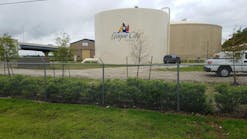Predictive maintenance can help save money, safeguard assets
Water treatment processes are complex operations that require extensive measurement of multiple parameters for quality, safety, and environmental purposes.
With the world’s population projected to increase exponentially over the next few years, the need to conserve and successfully prevent the pollution of the Earth’s water supplies has never been more urgent.
Although current practices — including metering technologies, construction of new storage infrastructures, and public awareness campaigns — are helping to address the issue of future water supply concerns, much still needs to be done.
Particular challenges include the need to minimize waste during the potable treatment and distribution stages, ensuring that water is correctly treated, and that, once this treated water enters the distribution pipe network, every drop is accounted for. Increasingly stringent legislation also demands that wastewater is returned to an acceptable standard before it is returned to the environment, with stiff financial penalties for any failure to comply.
In many cases, measurement instruments and analyzers not only provide the front line for assessing water quality throughout potable and wastewater treatment processes but also the efficiency of the treatment plant itself. Given the massive quantities of water that flow through treatment plants every day, it is vitally important that any problems that can be identified should be as quickly as possible.
This is where predictive maintenance can help.
What is Predictive Maintenance?
The technologies and techniques that are now driving the global move to Industry 4.0 and the Internet of Things (IoT) are providing vast amounts of data that can be used to create and analyze models for a wide range of tasks, including the ability to monitor the status of instruments and analyzers and identify when performance is deviating from normal.
These technologies have acted as a key enabler for predictive maintenance, making it possible for operators to proactively prevent potential problems by intervening before they can escalate.
For operators, a key advantage has been the ability to make informed decisions based on data that reflects actual operating conditions, either in real or near-real time. This is becoming increasingly desirable as the management of water supplies comes under pressure from the combined forces of population growth, rising urbanization, and growing industrialization. Each consumes large amounts of water and generates effluent waste that needs to be treated to the highest quality before being returned to the environment.
Key Advantages of Predictive Maintenance
It is important to distinguish between predictive maintenance and the more traditional “run-to-fail” and preventive maintenance approaches.
Run-to-fail literally means, “Let it run until it goes wrong; then fix it.” Where water systems are concerned, this is the least attractive option, especially when human and animal safety are involved or crops are under threat.
Preventive maintenance is the most common approach and is often a central tenet of daily industrial operations. However, this approach can be unnecessarily costly because it can mandate refurbishment or replacement of devices and systems that are perfectly serviceable and have long lives ahead of them — while allowing other less robust devices or systems to slowly deteriorate and eventually fail. The problem is that operators don’t always know what is good versus what is going bad, so they replace it all.
Predictive maintenance takes advantage of modern sensing, data gathering, and analysis algorithms to continually evaluate the state of an instrument or device that is being used to ensure safe water supplies. The ability to compare current data with historical trends can provide highly accurate models of what to expect in the future. This enables the user to not only take steps to predict the likelihood of supply and service issues but also to identify precisely where those problems are likely to occur and schedule their resolution. Predictive maintenance can save operators considerable sums of money by only scheduling maintenance where it is expected to be needed rather than applying it as a blanket policy.
The Critical Roles of Machine Learning and Artificial Intelligence
Machine learning (ML) and artificial intelligence (AI) are set to play an increasingly critical role in optimizing the efficiency, performance, and management of potable and wastewater treatment plants and networks.
Machine learning can be rapidly trained to learn from anomalies that negatively affect water treatment and distribution issues and predict when and where they will occur. More highly targeted maintenance can therefore be planned and carried out in far less time yet be far more effective.
Drawing on data to proactively identify equipment that is likely to cause problems prevents multiple teams from addressing issues that don’t exist, enabling better and more cost-effective deployment of engineering teams and eliminating unnecessary downtime.
Remaining Issues
That’s not, however, to say that predictive maintenance is a panacea for water conservation and future supply guarantees. It must be adopted and implemented, which requires buy-in by those who run an operation. That’s not always an easy sell, often for one reason: Predictive maintenance is proven to work, but it requires data. Lots of data. And this is where some organizations find themselves pausing, and sometimes stalling, their implementation.
Where and how do you store and process all that data? For how long? At what cost? Who owns it?
New Solutions Are at Hand
New techniques for implementing predictive maintenance for water treatment and supply planning are rapidly becoming mainstream. However, they require a degree of expertise to evaluate the best solution for a specific end use and many companies lack the in-house resources to take those decisions internally.
Even with many decades of experience in water system management, the application of IoT technologies and techniques to legacy practices can be daunting. Thankfully, many suppliers of data-gathering technologies can help offer solutions to make this transition as painless as possible.
Time to Act
A new generation of sensors and instrumentation will enable us to meet the water demands of the near future. Predictive maintenance will save money, increase efficiency, and, most important, conserve and perhaps expand the availability of our most precious resource. WW





